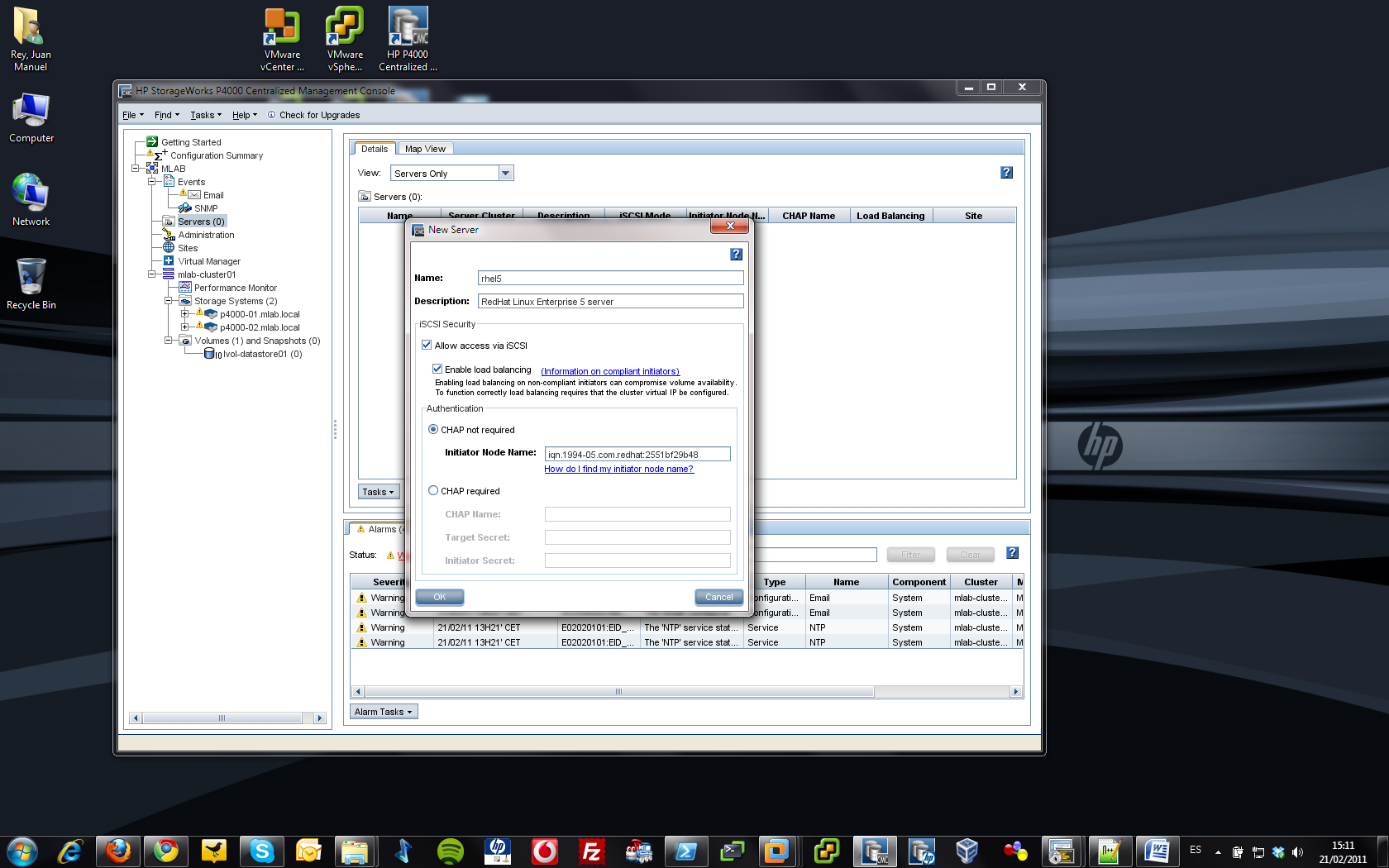iSCSI initiator configuration in RedHat Enterprise Linux 5
The following post will discuss about iSCSI initiator configuration in RedHat Enterprise Linux 5, this method is also applicable to all RHEL5 derivatives. The iSCSI LUNs will be provided by an HP P4000 array.
First of all we need to get and install the iscsi-initiator-utils RPM package, you can use yum to get and install the package from any supported repository for CentOS or RHEL. You can also download the package from RedHat Network if you have a valid RHN account and your system doesn’t have internet connection.
[root@rhel5 ~]# rpm -ivh /tmp/iscsi-initiator-utils-6.2.0.871-0.16.el5.x86_64.rpm
Preparing... ########################################### [100%]
1:iscsi-initiator-utils ########################################### [100%]
[root@rhel5 ~]#
[root@rhel5 ~]#rpm -qa | grep iscsi
iscsi-initiator-utils-6.2.0.871-0.16.el5
[root@rhel5 ~]# rpm -qi iscsi-initiator-utils-6.2.0.871-0.16.el5
Name : iscsi-initiator-utils Relocations: (not relocatable)
Version : 6.2.0.871 Vendor: Red Hat, Inc.
Release : 0.16.el5 Build Date: Tue 09 Mar 2010 09:16:29 PM CET
Install Date: Wed 16 Feb 2011 11:34:03 AM CET Build Host: x86-005.build.bos.redhat.com
Group : System Environment/Daemons Source RPM: iscsi-initiator-utils-6.2.0.871-0.16.el5.src.rpm
Size : 1960412 License: GPL
Signature : DSA/SHA1, Wed 10 Mar 2010 04:26:37 PM CET, Key ID 5326810137017186
Packager : Red Hat, Inc. <http://bugzilla.redhat.com/bugzilla>
URL : http://www.open-iscsi.org
Summary : iSCSI daemon and utility programs
Description :
The iscsi package provides the server daemon for the iSCSI protocol,
as well as the utility programs used to manage it. iSCSI is a protocol
for distributed disk access using SCSI commands sent over Internet
Protocol networks.
[root@rhel5 ~]#
Next we are going to configure the initiator. The iSCSI initiator is composed by two services, iscsi and iscsid, enable them to start at system startup using chkconfig.
[root@rhel5 ~]# chkconfig iscsi on
[root@rhel5 ~]# chkconfig iscsid on
[root@rhel5 ~]#
[root@rhel5 ~]# chkconfig --list | grep iscsi
iscsi 0:off 1:off 2:on 3:on 4:on 5:on 6:off
iscsid 0:off 1:off 2:on 3:on 4:on 5:on 6:off
[root@rhel5 ~]#
Once iSCSI is configured start the service.
[root@rhel5 ~]# service iscsi start
iscsid is stopped
Starting iSCSI daemon: [ OK ]
[ OK ]
Setting up iSCSI targets: iscsiadm: No records found!
[ OK ]
[root@rhel5 ~]#
[root@rhel5 ~]# service iscsi status
iscsid (pid 14170) is running...
[root@rhel5 ~]#
From P4000 CMC we need to add the server to the management group configuration like we would do with any other server.
The server iqn can be found in the file /etc/iscsi/initiatorname.iscsi.
[root@cl-node1 ~]# cat /etc/iscsi/initiatorname.iscsi
InitiatorName=iqn.1994-05.com.redhat:2551bf29b48
[root@cl-node1 ~]#
Create any iSCSI volumes you need in the P4000 arrays and assign them to the RedHat system. Then to discover the presented LUNs, from the Linux server run the iscsiadm command.
[root@rhel5 ~]# iscsiadm -m discovery -t sendtargets -p 192.168.126.60
192.168.126.60:3260,1 iqn.2003-10.com.lefthandnetworks:mlab:62:lv-rhel01
[root@rhel5 ~]#
Restart the iSCSI initiator to make the new block device available to the operative system.
[root@rhel5 ~]# service iscsi restart
Stopping iSCSI daemon:
iscsid dead but pid file exists [ OK ]
Starting iSCSI daemon: [ OK ]
[ OK ]
Setting up iSCSI targets: Logging in to [iface: default, target: iqn.2003-10.com.lefthandnetworks:mlab:62:lv-rhel01, portal: 192.168.126.60,3260]
Login to [iface: default, target: iqn.2003-10.com.lefthandnetworks:mlab:62:lv-rhel01, portal: 192.168.126.60,3260]: successful
[ OK ]
[root@rhel5 ~]#
Then check that the new disk is available, I used lsscsi but fdisk -l will do the trick too.
[root@rhel5 ~]# lsscsi
[0:0:0:0] disk VMware, VMware Virtual S 1.0 /dev/sda
[2:0:0:0] disk LEFTHAND iSCSIDisk 9000 /dev/sdb
[root@rhel5 ~]#
[root@rhel5 ~]# fdisk -l /dev/sdb
Disk /dev/sdb: 156.7 GB, 156766306304 bytes
255 heads, 63 sectors/track, 19059 cylinders
Units = cylinders of 16065 * 512 = 8225280 bytes
Disk /dev/sdb doesn't contain a valid partition table
[root@rhel5 ~]#
At this point the iSCSI configuration is done, the new LUNs will be available through a system reboot as long as the iSCSI service is enabled.
Juanma.


Comments